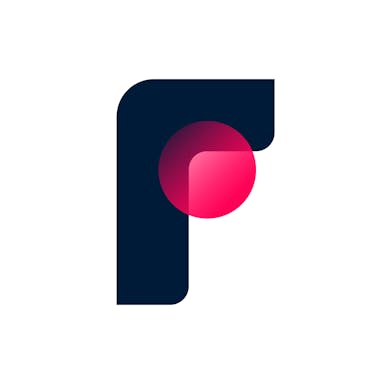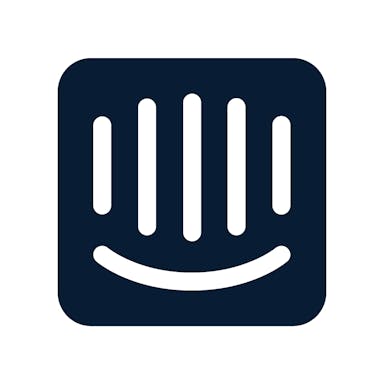Thesis
For knowledge workers, communication with customers, co-workers, subordinates, and other stakeholders is a frequent part of the job. Knowledge work spans a wide variety of roles, including sales, customer success, finance, product, engineering, and others. In the modern economy, knowledge workers make up a significant portion of the workforce; there are over 100 million knowledge workers in the United States and over 1 billion globally. As technology increasingly automates repetitive tasks, knowledge work will involve the management of greater complexity.
Despite the proliferation of productivity management and communications software over the past decade, email continues to reign as the universally accepted tool for business communication. More than 1 billion people were using email at work as of 2020, 86% of workers preferred email when it came to business communication, and over half of knowledge workers said that email would be the most difficult tool to work without. While email has evolved over time, adequate workflow support, analytics, or integrations are often lacking. With organizations employing a multitude of platforms, knowledge workers often find themselves spending valuable hours toggling between communication tools, leading to inefficiency in the attempt to foster and maintain strong customer relationships.
Front is an email and customer support SaaS tool that provides a communication hub for building strong customer relationships. With Front, teams can centralize messages across channels, route them to the right person, and unlock visibility and insights across customer operations. The initial manifestation of Front’s vision revolved around creating collaborative inboxes, enabling users to engage in ephemeral chats within email threads. This product gained traction amongst success and support teams, who handle high volumes of customer interactions on a daily basis. However, with a bottom-up, land-and-expand strategy, the company has emerged as a dynamic communication hub for all customer-facing teams. Front aims to become a central hub of communications.
Founding Story
Front was founded in 2013 by Mathilde Collin (CEO and co-founder) and Laurent Perrin (CTO and co-founder). Collin and Perrin first crossed paths at eFounders, a startup accelerator program in Paris, France. Collin, who completed studies in mathematics and entrepreneurship at HEC Paris, decided to leave her job at a SaaS company due to her disappointment with its culture. Perrin, an engineer, was actively seeking a new opportunity after serving as the CTO of a French online radio service for almost four years.
At eFounders, the duo brainstormed and came up with the thought that a collaborative email inbox could help embed their product in a company’s workflows. The idea was that, instead of a customer email setting off a chain reaction inside a business of multiple internal communications, users would be able to use a shared email to treat customer communications like live documents — allowing for comments, tags, and drafted response without the need to send additional emails.
In 2014, having already onboarded around a dozen test companies as customers, the co-founders left Europe to interview for Y Combinator (YC) in San Francisco. Collin pitched the concept of Front to YC partners, including Geoff Ralston and Paul Buchheit, the creators of Yahoo Mail and Gmail respectively. Front was accepted as part of the YC Summer 2014 batch.
Product
Collaboration
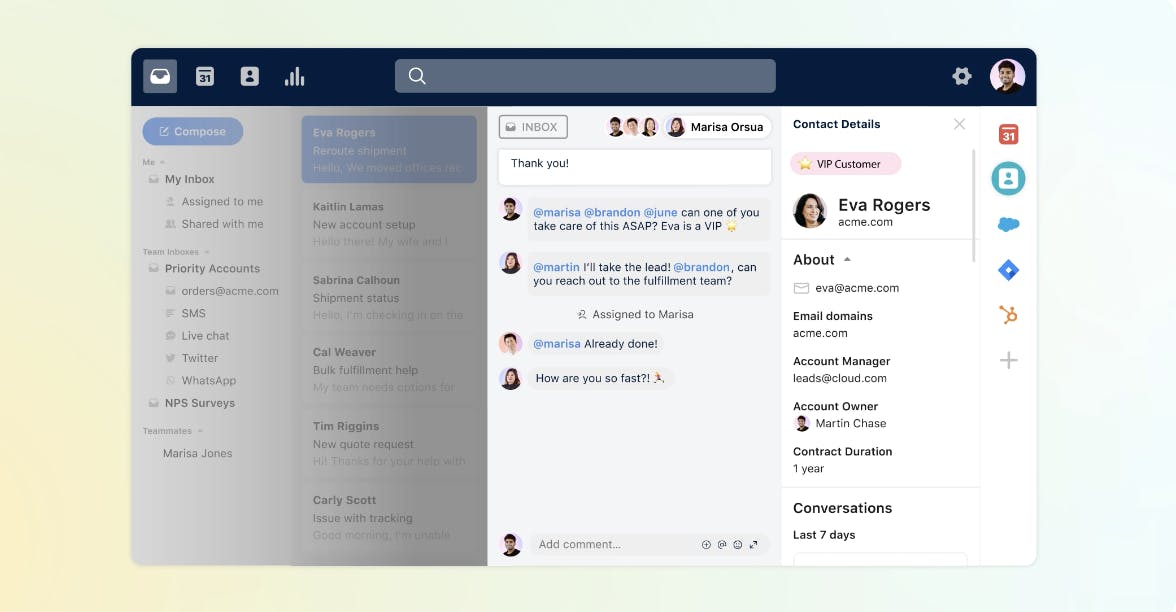
Source: Front
Front’s collaboration tools are intended to help teams work more easily together to respond to customers. The collaboration tools it offers include shared inboxes, AI summaries, project management, internal discussion capabilities, collision detection (preventing duplicate replies), a slack integration, and the ability to loop in non-Front users to a message as a conversation “guest”.
Of these, Front's Shared Inbox integrates internal chat and email functionalities, providing teams with unified hubs designed specifically for team-centric communication and collaboration. This feature offers a collective perspective on every email by combining distribution lists, group email aliases, and other collaborative tools.
Unlike traditional methods of involving teammates through cc's or forwarded messages, Front's Shared Inbox allows users to internally comment on emails, engage in behind-the-scenes discussions, and collaborate on drafting email replies together. This approach is intended to enhance team coordination, facilitate efficient communication, and eliminate the need for cumbersome email chains or scattered conversations.
Users can also establish automated workflow rules in Front to efficiently organize incoming requests, assign them to the right team members, and set up service-level agreement (SLA) alerts. These rules can be applied and shared at both team and individual levels, ensuring personalized and consistent workflows. By defining company-wide rules, businesses can enforce SLAs, automate responses, and lower resolution times.
Workflow Automation
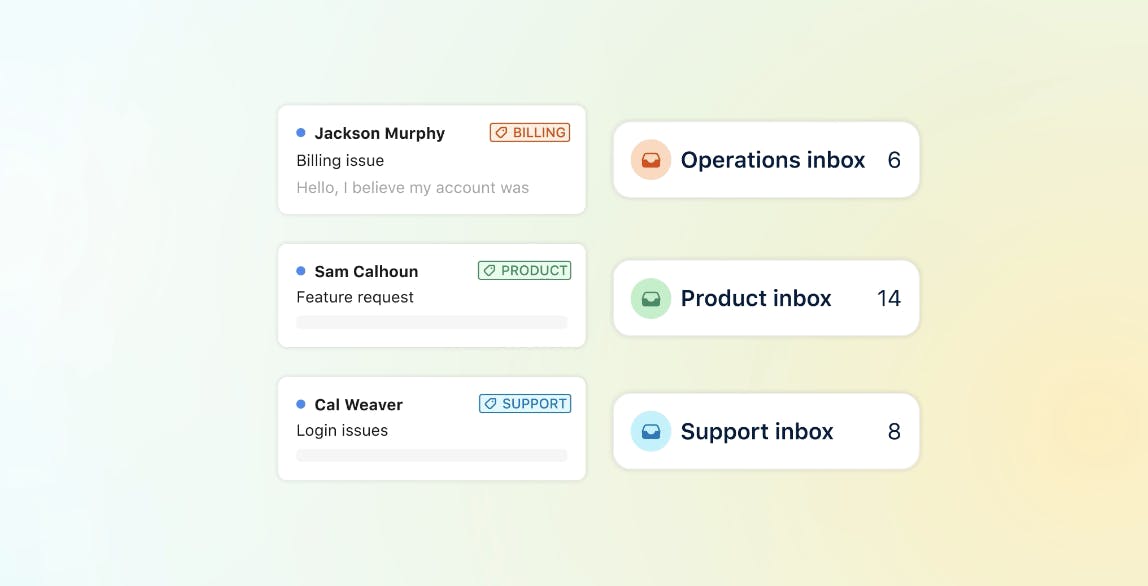
Source: Front
Analytics
Front provides analytics and reporting capabilities that capture insights into team performance, conversation response times, customer satisfaction metrics, and other key data points. This feature plays an important role in tracking and enhancing customer communication effectiveness, as well as providing teams and individuals with a deeper understanding of their own performance.
With Front, users may generate reports that can be customized to filter specific dimensions such as inboxes, channels, teammates, tags, or any combination of these criteria. This allows for granular analysis of communication metrics and facilitates targeted improvements based on specific areas of focus.
Omnichannel Inbox
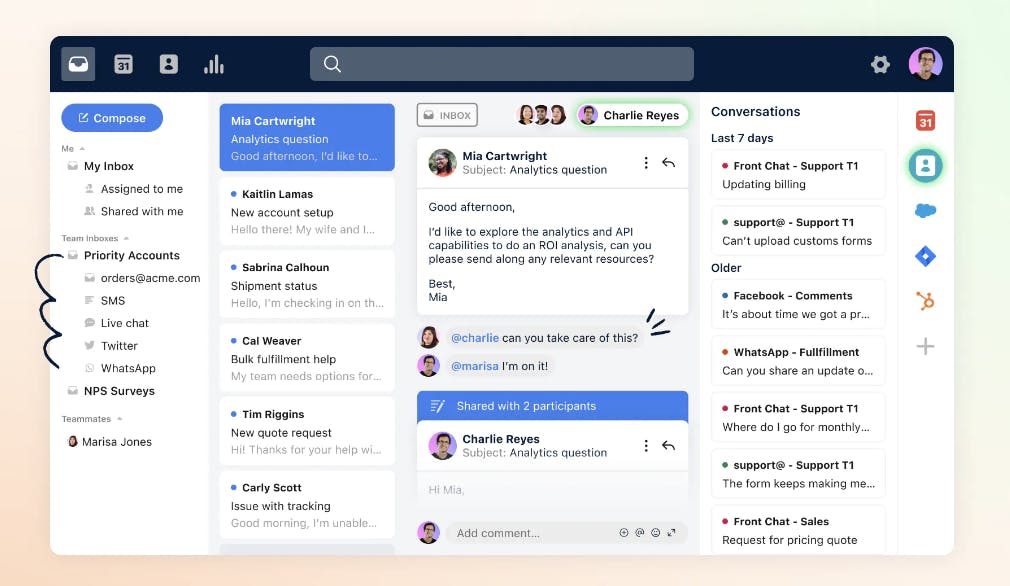
Source: Front
Front's omnichannel inbox consolidates messages from various channels, such as email, SMS, live chat, and social media, into a unified interface. Users can leverage advanced features, including workflow rules and assignments based on keywords, senders, and time of day, ensuring messages are directed to the appropriate recipients in a timely manner.
By bringing all incoming communications into one platform, Front's Universal Inbox streamlines workflows for individual users, resulting in improved response times and enhanced efficiency in managing messages across different channels. This consolidated approach is intended to help users maintain context across conversations.
Integrations & APIs
Front offers integrations with a diverse range of tools, including popular options across different categories. Some notable integrations include:
CRMs: Front integrates with leading CRM platforms like Salesforce and Pipedrive.
Project management apps: Users can connect Front with project management systems such as Jira, Asana, GitHub, and Trello for streamlined collaboration.
Channel and messaging tools: Front integrates with popular communication tools like Slack and Twilio, enabling efficient team communication and message handling.
Automation/productivity tools: Users can enhance their workflows by integrating Front with automation and productivity tools like Zapier, facilitating data transfer and task automation.
AI tools: Front also provides integrations with AI tools such as UpBrains AI, empowering users with AI-driven capabilities.
Front also offers add-ons such as Google Business Messages, Telegram, and Dialpad SMS. These integrations and add-ons allow Front users to utilize and consolidate a wide array of tools within a unified platform.
Front also offers a range of APIs that empower users to develop personalized workflows and user interfaces. The platform is made up of three primary APIs: Core API, Plugin SDK, and Channel API. Front ensures developers have access to detailed documentation, including step-by-step walkthroughs, code examples, and additional resources, facilitating the integration and utilization of these APIs.
Mobile App
Front offers a mobile application that is available on both Apple iOS and Android devices. The app allows teams to access and manage their shared inbox and customer communication channels from anywhere. However, certain advanced features available on the desktop version, such as user onboarding, template and automation customization settings, analytics, and more, are not supported on the mobile app as of August 2023.
Market
Customer
Front’s software caters to industries that typically manage a high volume of customer inquiries. Front’s homepage lists solutions for sectors including B2B technology, financial services, logistics, manufacturing, professional services, and travel. Within organizations, the platform primarily services the workflows of support, operations, inbound sales, account management, and success teams. In 2022, Front reported particular traction in the mid-market and enterprise sectors, where new business expanded at a rate almost twice as fast as in other segments.
Across its listed industries, Front offers an array of different use cases. The platform’s flexible nature allows organizations across various sectors to adapt and customize the platform to suit their unique requirements. Some examples include:
Professional services organizations: Front may serve as a tool for facilitating collaboration between account managers and subject matter experts.
B2B technology success & account management teams: Front may streamline communications such that customers receive timely, accurate, and personalized responses.
Financial services organizations: Front may help prioritize customer relationships and reduce response times.
Logistics organizations: Front may enhance incoming customer request workflows and reduce the time required to generate quotes.
Market Size
Front lies across several markets. In 2023, the market size of customer success platforms was projected to increase from $1 billion in 2020 to $2.5 billion by 2025, representing a projected CAGR of 20.4%. Meanwhile, the global email marketing software market was valued at $1.1 billion in 2020 and is projected to reach $2.5 billion by 2028, a CAGR of 10.7%. Its growth is attributed to the continued adoption of digital marketing by an increasingly wide array of businesses.
To the extent that Front can achieve its goal of becoming a communication and collaboration layer for knowledge workers as a whole, its TAM might be seen as much larger than these markets, however. Knowledge workers represent a large and growing portion of today’s workforce. Gartner estimates the number of knowledge workers in the US at over 100 million, and over 1 billion globally. If Front can achieve sufficient traction, it may address the needs of a significant portion of knowledge workers as a whole. In its Series D deck, Front estimated its revenue opportunity on “core use cases” at $13 billion.
Competition
Zendesk: Zendesk is a leading customer experience SaaS platform. Its range of features includes ticketing systems, live chat functionality, cloud-based call centers, CRM tools, and more. Founded in Copenhagen in 2007, Zendesk served more than 170K customers globally as of 2021. In response to pressure from activist investors, the company made the decision to go private through a $10.2 billion acquisition led by Permira and Hellman & Friedman in June 2022. Previously, Zendesk had a successful IPO in 2014, raising $100 million at a $1.7 billion valuation. Early investors included firms such as Benchmark, CRV, Redpoint, and Matrix Partners.
Freshworks: Freshworks is a customer service, IT, and CRM SaaS company that provides a range of products to 60K+ customers as of February 2023. Founded in 2010, the company offers solutions spanning customer support, sales, marketing, and more. The Freshdesk platform is a primary Front competitor and helps support teams manage tickets, automate workflows, and engage with customers in real time. In 2019, Freshworks announced a $150 million Series H round led by Sequoia Capital, CapitalG (formerly Google Capital), and Accel on a $3.5 billion valuation. The company has raised a total of $484 million in funding.
Intercom: Intercom is a conversational marketing SaaS platform that aims to improve businesses’ interactions with potential or existing customers. The company was founded in 2011. In 2018, Intercom announced a $125 million Series D at a $1.3 billion valuation led by Kleiner Perkins, with participation from Google Ventures. In total, the company has raised $241 million in funding and had an estimated 2022 revenue of $250 million. Existing investors include Bessemer Venture Partners, Index Ventures, Jack Dorsey, and Mark Zuckerberg. The company emphasizes its focus on a "messaging-first approach" assisting its clients in customer acquisition and support endeavors.
Business Model
Front operates on a subscription-based business model, where customers are charged fees on a per-seat, per-month basis, billed annually. The company offers four tiers of subscription packages at increasing price points: Starter, Growth, Scale, and Premier. Each tier provides users with basic features such as omnichannel messaging and team collaboration on customer messages.
Starter ($19/seat/month, billed annually, 2-10 seats): This tier is best suited for small teams. Features include omnichannel messaging, team collaboration on customer messages, calendar, one-click meeting scheduling, and access to most 3rd-party integrations.
Growth ($59/seat/month, billed annually, minimum 5 seats): This tier caters to small and/or growing teams. Features include all Starter offerings, plus guided rule templates, workflow automations, omnichannel communications, collaborative inboxes, out-of-the-box integrations (i.e., CRM, automation, and voice communication and telephony), and reporting and analytics for team performance, customer satisfaction, SLAs, and more.
Scale ($99/seat/month, billed annually, minimum 20 seats): This tier is intended to serve teams that need flexibility for customized workflows and team management, as well as enterprise-level security. Features include all Starter and Growth offerings, plus flexible rule options, detailed insights with account-based analytics, enterprise-grade security, and compliance, team management (i.e., SCIM/user provisioning, SSO, custom roles and permissions, and more), and onboarding and solution design.
Premier ($229/seat/month, billed annually, minimum 50 seats): This tier is built for enterprise teams looking for extensive services and partnership needs. Features include all Starter, Growth, and Scale offerings, plus higher usage caps across all features, additional success services (i.e., Premier Onboarding), customer build hours (i.e., API advisory and integration development), and video conferencing support.
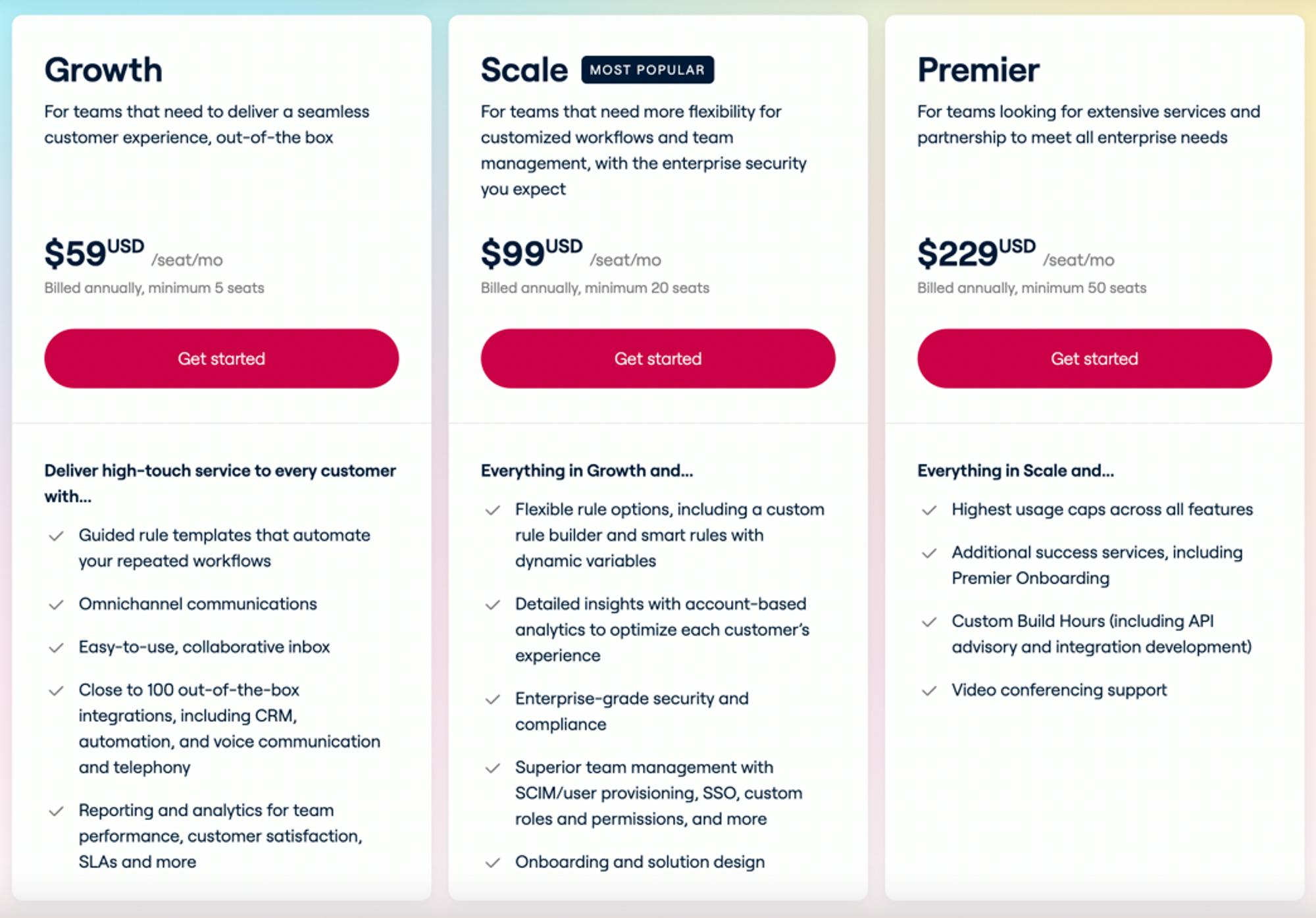
Source: Front
These pricing tiers allow Front to serve a broad spectrum of users, from small businesses to enterprise-grade clients, while generating recurring revenue from paid subscriptions. Front also allows customers to personalize their subscription plan with a range of available add-ons, such as Google Messages ($100/month), Telegram ($100/month), and Dialpad SMS ($100/month).
Traction
Front reported 120% YoY growth in net new ARR in 2022. By June 2022, Front had over 8K customers in 100+ countries, spanning small businesses to large enterprises (including notable companies such as Dropbox, GoDaddy, Cisco, Carvana, and more).

Source: Front
The Front platform has also seen positive signals regarding retention, with an average customer satisfaction (CSAT) score of 98%, and consistently sees a level of engagement more commonly seen amongst consumer apps than in B2B SaaS: 75% of Front’s monthly active users are also daily active users, whereas its rare among SaaS products to see this figure at even 50%. Additionally, Front’s Series D deck reported 130%+ net retention.
Valuation
In June 2022, Front announced a $65 million Series D round led by Salesforce Ventures and Battery Ventures, with participation from PagerDuty CEO Jennifer Tejada. Existing investors Sequoia Capital, Threshold Ventures, and Uncork Capital also participated in the financing. This round valued Front at $1.7 billion and brought the company’s total funding to $204 million. The company approximately doubled its Series C valuation of $859 million in its Series D.
Key Opportunities
Partnerships and Integrations
Front's integration marketplace serves as a catalyst for fostering user-developer network effects, establishing a self-reinforcing cycle of value creation. As Front’s user base grows, the company is well positioned to attract a greater number of developers. By nurturing a strong developer community, Front can encourage the creation of integrations and extensions that enhance its functionality, enabling users to customize the platform to their specific requirements. This versatility could not only attract new users from both existing clients and new logos but could also enable Front to compete effectively against sophisticated competitors such as Zendesk. Additionally, integrations could drive higher prices and increase average revenue per customer.
Advancements in AI
Alongside recent announcements of AI-powered features like Compose with AI and Summarize with AI, Front may also consider implementing additional functionalities such as smart inbox organization, intelligent search, and personalized customer recommendations. By enhancing communication processes with AI, Front can help teams to operate more efficiently and deliver exceptional customer service.
Demand for Collaboration Software
With an increasing volume of hybrid or remote workplaces, distributed teams are seeking solutions that streamline collaborative efforts. In parallel, many apps have emerged to solve the differing pain points amongst knowledge workers. This has created a new problem set, wherein teams must toggle between multiple platforms to manage their work. As a result, workers spend extra time doing their jobs and are more likely to become distracted between tasks. Front, with its comprehensive range of features and intuitive interface, acts as an all-encompassing communication hub. This unique positioning could allow it to consolidate organizational communication on its platform and effectively capitalize on this trend.
Key Risks
Competitive Landscape
Content collaboration platforms like Google Workspace and Microsoft 365 have consistently held a prominent position in the realm of productivity software, thanks to their comprehensive product bundles and widespread distribution channels. While they may not provide sophisticated workflow functionality, they are typically implemented horizontally across entire organizations. This is a challenge for new entrants on a converging course. For example, when Microsoft granted all Office users access to Teams, they quickly surpassed Slack’s growth. Similarly, Front runs the risk of one of these players creating their own competing tool. This risk is exacerbated by the fact that Front requires users to bring their own email domains to the platform, which Google and Microsoft provide.
Meanwhile, Zendesk and Intercom, which serve as workflow tools within specific functional units, pose distinct threats. Zendesk has a strong position in the sales and support market with over 170K customers, leveraging their access to extensive company support data to effectively sell add-on features like live chat, voice chat, analytics, and knowledge bases. Similarly, Intercom, with a user interface like Front, leads the conversational marketing segment with over 25K customers. Unlike Front, Intercom can be embedded in customers' websites, providing users with valuable website traffic details. This data enables personalized customer interactions, resulting in strong touchpoints for sales, support, and marketing.
Despite these competitive threats, Front’s powerful engagement and retention metrics indicate its ongoing market strength. With a growing integration marketplace, the company does not necessarily need to build its own tools to sell horizontally across organizations in the short term. Additionally, Front's versatile nature as a company-wide communication layer encourages users to dedicate more time within the platform compared to using individual point solutions such as Zendesk and Intercom. Regardless, Front should continue its meaningful expansion beyond core use cases of email and customer support to maintain stickiness and competitive advantage.
Versatile but Unspecialized
Front initially emerged as a collaborative alternative to the traditional email inbox, but the company holds a bold vision for its future. While serving as a communication hub primarily for customer-facing teams, Front aspires to extend its reach and cater to all knowledge workers, ultimately evolving into an organization-wide collaboration layer. This strategy expands the potential customer base for Front, but it also poses challenges in terms of maintaining focus, quality, and functionality for individual use cases. Over time, this could potentially diminish Front’s appeal to prospective customers and its value proposition to existing customers as their businesses expand.
Summary
Front launched in 2013 and has raised $204 million in funding as of August 2023. Front aims to enable better relationships at scale, offering a comprehensive communication hub for customer-facing teams to orchestrate their collaborative operations and forge strong customer relationships. Since its inception, the company has held an ambitious vision of upending traditional email and customer support processes. Despite facing significant competition, Front has grown to 8K customers. Front wants to become the communication layer for all knowledge workers. The company reported 130%+ net retention in 2022. Front must carefully continue to carve out a meaningful expansion beyond core use cases of email and customer support to maintain its trajectory.
